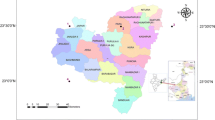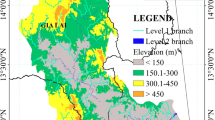Abstract
In this study, using Analytic Hierarchy Process (AHP) and Geographic Information System (GIS), the sensitivity to the occurrence of different types of droughts including meteorological drought (Med), hydrological drought (Hyd), and agricultural drought (Agd) were evaluated. In this research, at first, some of the effective indicators in each type of droughts were selected (four indicators in Med, three indicators in Hyd, and seven indicators in Agd), then using the ArcGIS 10.3 software, the sensitivity map of drought for each indicator were prepared (all indicators classified in four classes including mild, moderate, severe, and very severe). Then, using the AHP method the weight of each indicator in each type of droughts was determined and the final map of drought sensitivity for different types of droughts was prepared by superposition the maps of effective indicators in each drought. The final map of drought sensitivity was prepared by superposition the Med, Hyd, and Agd sensitivity maps (after determining the weight of each using AHP). In the Med, 43.29% of the study area (Fars province, Iran) was classified in the moderate class of drought sensitivity and 56.71% in the severe class. In the Hyd, 0.46%, 33.25%, 62.49%, and 3.80% of the study area were classified in the mild, moderate, severe, and very severe classes (respectively), and in the Agd, 1.18%, 50.23%, and 48.59% of the study area were classified in the mild, moderate, and severe classes. The results showed that in final drought sensitivity, the Med with a weight equal to 0.36 was the most effective variable, and based on the final map, 38.26% and 61.74% of the study area were classified in the moderate and severe classes of drought sensitivity.








Similar content being viewed by others
Data Availability
The data used in this research are available with the corresponding author and can be shared upon reasonable request.
References
Akbari M, Najafi Alamdarlo H, Mosavi SH (2021) Analysis of the effects of drought risk management using water productivity indicators. J Nat Environ Hazards 10(27):1–1
Asrari E, Masoudi M, Hakimi SS (2012) GIS overlay analysis for hazard assessment of drought in Iran using Standardized Precipitation Index (SPI). J Ecol Environ 35(4):323–329
Buurman J, Bui DD, Du LTT (2020) Drought risk assessment in Vietnamese communities using household survey information. Int J Water Resour Dev 36(1):88–105
Caceres C (2021) A Climate Change Vulnerability Assessment among Small Farmers: A Case Study in Western Honduras (Doctoral dissertation, The Claremont Graduate University)
Cai W, Chettiar UK, Kildishev AV, Shalaev VM (2007) Opt Cloak Metamater Nat Photo 1(4):224–227
Chen QY, Costa M (2021) Arsenic: a global environmental challenge. Annu Rev Pharmacol Toxicol 61:47–63
Dai M, Huang S, Huang Q, Leng G, Guo Y, Wang L, Fang W, Li P, Zheng X (2020) Assessing agricultural drought risk and its dynamic evolution characteristics. Agric Water Manag 231, 106003
Deng Y, Wang X, Wang K, Ciais P, Tang S, Jin L, Li L, Piao S (2021) Responses of vegetation greenness and carbon cycle to extreme droughts in China. Agric Forest Meteorol 298, 108307
Etemadi M, Karami EA, Zamani GH (2014) Social Vulnerability to Drought and Its Determinants: The Case of Fig Growers in Estahban, Fars Province. Iranian Agric Exten Educ J 10(1):63–73
Farsani NT, Jamshidi HM, Mortazavi M, Eslamian S (2021) Water Harvesting and Sustainable Tourism. Handbook of Water Harvesting and Conservation: Basic Concepts and Fundamentals 447–455
Hellwig J, Stoelzle M, Stahl K (2021) Groundwater and baseflow drought responses to synthetic recharge stress tests. Hydrol Earth Syst Sci 25(2):1053–1068
Hoque MAA, Pradhan B, Ahmed N, Sohel MSI (2021) Agricultural drought risk assessment of Northern New South Wales, Australia using geospatial techniques. Sci Total Environ 756, 143600
Hoque MAA, Pradhan B, Ahmed N (2020) Assessing drought vulnerability using geospatial techniques in northwestern part of Bangladesh. Sci Total Environ 705, 135957
Jokar P, Masoudi M, Shamsi SRF, Afzali SF (2015) Developing a model for ecological capability evaluation of ecotourism (A case study: Jahrom Township, Iran). Interna J Scie Res Environ Sci 3(1):1
Keshavarz M, Maleksaeidi H, Karami E (2017) Livelihood vulnerability to drought: A case of rural Iran. Intern J Disaster Risk Reduct 21:223–230
Khosravi H, Zehtabian G, Ahmadi H, Azarnivand H, Ghaiebi HG (2014) Hazard assessment of desertification as a result of soil and water recourse degradation in Kashan Region. Iran Desert 19(1):45–55
Kim H, Park J, Yoo J, Kim TW (2015) Assessment of drought hazard, vulnerability, and risk: A case study for administrative districts in South Korea. J Hydro-Environ Res 9(1):28–35
Lin ZC, Yang CB (1996) Evaluation of machine selection by the AHP method. J Mater Process Technol 57(3–4):253–258
Mahdavi M 2002 Applied Hydrology Tehran University Press 2 149
Masoudi M, Jokar P, Ramezanipour E (2020) A GIS-based quantitative model for land use planning in Larestan County. Iran EQA-Intern J Environ Quality 40:19–30
Masoudi M, Elhaeesahar M (2019) GIS analysis for vulnerability assessment of drought in Khuzestan province in Iran using standardized precipitation index (SPI). Iran Agricultural Research 38(2):9–16
Masoudi M, Asrari E (2009) Risk assessment of desertification using GIS in parts of Mond Basin, Southern Iran. In Advances in studies on desertification, Murcia 16–18 September, 2009
Miller SL, Gongloff A (2021) Fairy rings, associated fungi, and assessment of their distribution across environmental variables using GIS. Fungal Ecol 50, 101040
Mokarram M, Zarei AR (2018) Landslide susceptibility mapping using fuzzy-AHP. Geotech Geol Eng 36(6):3931–3943
Mu Q, Cai H, Sun S, Wen S, Xu J, Dong M, Saddiqu Q (2021) The physiological response of winter wheat under short-term drought conditions and the sensitivity of different indices to soil water changes. Agric Water Manag 243 106475
Niaz MA, Faiz MA, Yongxia W (2021) Development of an integrated weighted drought index and its application for agricultural drought monitoring. Arab J Geosci 14(6):1–12
Orimoloye IR, Belle JA, Olusola AO, Busayo ET, Ololade OO (2021) Spatial assessment of drought disasters, vulnerability, severity and water shortages: a potential drought disaster mitigation strategy. Nat Hazards 105(3):2735–2754
Plummer R, Baird J (2021) The emergence of water resilience: An introduction. In Water Resilience (3–19). Springer, Cham
Rani NS, Satyanarayana ANV, Bhaskaran PK, Rice L, Kantamaneni K (2021) Assessment of groundwater vulnerability using integrated remote sensing and GIS techniques for the West Bengal coast, India. J Contamin Hydrol 238, 103760
Rajsekhar D, Singh VP, Mishra AK (2015) Hydrologic drought atlas for Texas. J Hydrol Eng 20(7):05014023
Saaty T (1980) The analytic hierarchy process (AHP) for decision making. In Kobe, Japan
Saaty TL (1984) The analytic hierarchy process: Decision making in complex environments. In Quantitative Assessment in Arms Control (285–308). Springer, Boston, MA
Saaty TL (2008) Decision making with the analytic hierarchy process. International Journal of Services Sciences 1(1):83–98
Shamsnia SA, Khodadadi Dehkordi D (2020) Agricultural Drought Monitoring Using Reconnaissance Drought Index (RDI) and Kriging Geostatistical Model (Case Study: Central and Southern Regions of Fars Province). Environ Water Eng 6(4):444–458
Sharafi L, Zarafshani K, Keshavarz M, Azadi H, Van Passel S. (2020) Drought risk assessment: towards drought early warning system and sustainable environment in western Iran. Ecol Indic 114, 106276
Shen D (2021) Climatic Change and Water Resources. In Water Resources Management of the People’s Republic of China (pp. 409–430). Springer, Cham
Shi S. Yu J. Wang F, Wang P, Zhang Y, Jin K (2021a) Quantitative contributions of climate change and human activities to vegetation changes over multiple time scales on the Loess Plateau. Sci Total Environ 755,142419
Shi W., Wang M, Liu Y (2021b) Crop yield and production responses to climate disasters in China. Sci Total Environ 750, 141147
Tigkas D, Vangelis H, Tsakiris G (2020) Implementing crop evapotranspiration in RDI for farm-level drought evaluation and adaptation under climate change conditions. Water Resour Manage 34(14):4329–4343
Tsakiris G, Pangalou D, Vangelis H (2007) Regional drought assessment based on the Reconnaissance Drought Index (RDI). Water Resour Manage 21(5):821–833
United Nations Environmental Programme (UNEP) (1992) World Atlas of Desertification
Zakerinejad R, Masoudi M (2019) Quantitative mapping of desertification risk using the modified MEDALUS model: a case study in the Mazayejan Plain. Southwest Iran AUC Geograph 54(2):232–239
Zarei AR, Mahmoudi MR (2021) Evaluation and Comparison of the Effectiveness Rate of the Various Meteorological Parameters on UNEP Aridity Index Using Backward Multiple Ridge Regression. Water Resour Manage 35(1):159–177
Zarei AR, Shabani A, Mahmoudi MR (2019) Comparison of the climate indices based on the relationship between yield loss of rain-fed winter wheat and changes of climate indices using GEE model. Sci Total Environ 661:711–722
Zareiee AR, Masoudi M (2014) Evaluation of Drought Hazard Area of GharehAghaj Basin in Iran, Using GIS. Atmosph Clim Sci 4:147–154. https://doi.org/10.4236/acs.2014.42017
Zareiee AR, Masoudi M, Taghvaei M, Shams RF, Ganjei A (2011) Assessment of Meteorological Drought Hazard Area using GIS in Ghareh Aghaj basin. Iran J Appl Sci Environ Manag 15(1):25–30
Zehtabian Gh, Ahmadi H, Khosravi H, Rafiei Emam A (2005) The Approach of Desertification Mapping Using MEDALUS Methodology in Iran. BIABAN Journal 10(1):51–60
Zhang D, Sial MS, Ahmad N, Filipe AJ, Thu PA, Zia-Ud-Din M, Caleiro AB (2021) Water Scarcity and Sustainability in an Emerging Economy: A Management Perspective for Future. Sustainability 13(1):144
Zhang L, Song W, Song W (2020) Assessment of Agricultural Drought Risk in the Lancang-Mekong Region, South East Asia. Int J Environ Res Public Health 17(17):6153
Zhu X, Xu K, Liu Y, Guo R, Chen L (2021) Assessing the vulnerability and risk of maize to drought in China based on the AquaCrop model. Agric Syst 189:103040
Acknowledgements
We would like to thank Iran meteorological organization, water organization of Fars and Fars agricultural Jihad for providing the data series
Funding
No funds, grants, or other support was received.
Author information
Authors and Affiliations
Contributions
Abdol Rassoul Zarei contributed in the data collection, analyzing the results and writing the article, Mohammad Mehdi Moghimi contributed in analyzing the results and Elham Koohi contributed in the data collection.
Corresponding author
Ethics declarations
Ethics Approval
The authors confirm that this article is based on original research and has not been published or presented previously in any journal or conference in any language (in whole or in part).
Competing Interests
The authors have no conflict of interest.
Additional information
Publisher's Note
Springer Nature remains neutral with regard to jurisdictional claims in published maps and institutional affiliations.
Supplementary Information
Below is the link to the electronic supplementary material.
Rights and permissions
About this article
Cite this article
Zarei, A.R., Moghimi, M.M. & Koohi, E. Sensitivity Assessment to the Occurrence of Different Types of Droughts Using GIS and AHP Techniques. Water Resour Manage 35, 3593–3615 (2021). https://doi.org/10.1007/s11269-021-02906-3
Received:
Accepted:
Published:
Issue Date:
DOI: https://doi.org/10.1007/s11269-021-02906-3




